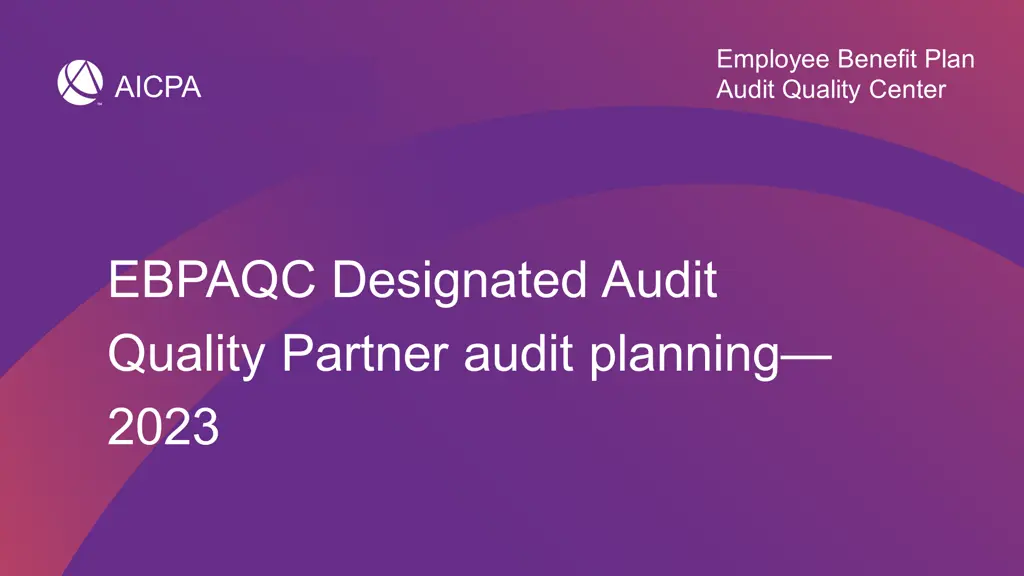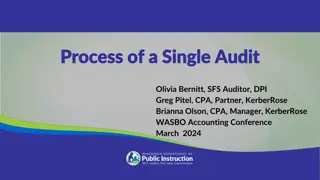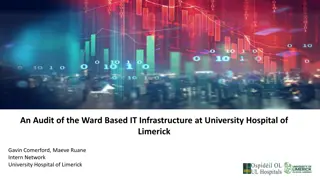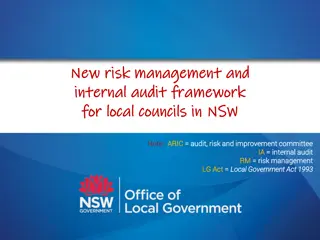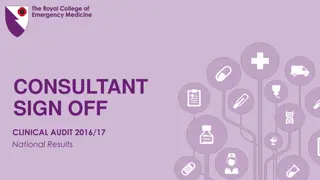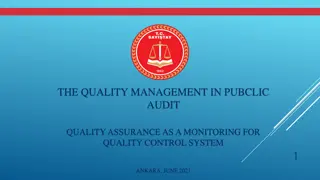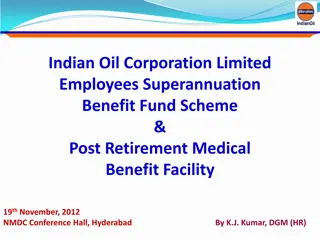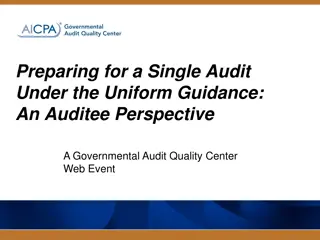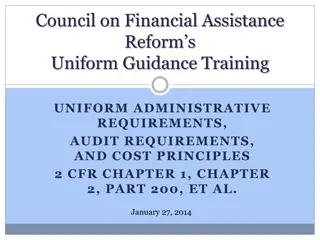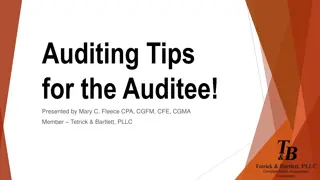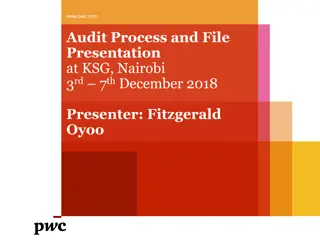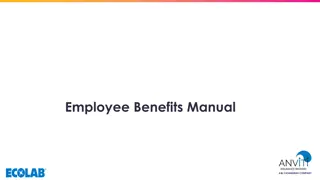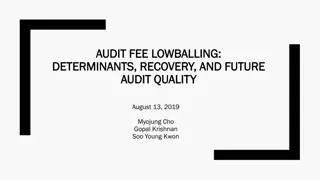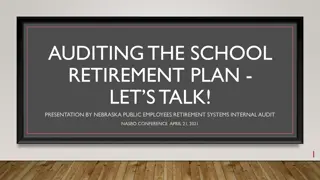Employee Benefit Plan Audit Quality Center 2023
The Employee Benefit Plan Audit Quality Center for a session on audit planning, DOL updates, legislative developments, and other audit considerations. Presented by industry experts.
Download Presentation

Please find below an Image/Link to download the presentation.
The content on the website is provided AS IS for your information and personal use only. It may not be sold, licensed, or shared on other websites without obtaining consent from the author. Download presentation by click this link. If you encounter any issues during the download, it is possible that the publisher has removed the file from their server.
E N D
Presentation Transcript
Employee Benefit Plan Audit Quality Center AICPA EBPAQC Designated Audit Quality Partner audit planning 2023
Presenters Michael Auerbach, DOL EBSA Debbie Smith, Grant Thornton LLP Josie Hammond, RSM US LLP Sandi Carrier, Deloitte
Todays topics DOL update Legislative, regulatory and industry developments 2022 audit season observations/what to expect in 2023 New auditing standards Other audit considerations and resources EBPAQC resources Q&A session
Handouts for todays event You can download presentation slides (in PDF or PowerPoint format) and other handouts by clicking on in the toolbar at the bottom of your screen Instructions to obtain your CPE certificate for today s event Webcast presentation slides EBPAQC primers: Actuarial methods and assumptions used in measuring plan benefit obligations in health and welfare benefit plans Timely remittance of employee contributions in defined contribution retirement plans EBPAQC tools: 2023 Special Considerations for EBP audits Firm preparedness checklist for EBP audits Employee benefit plan audit engagement acceptance and continuance considerations Analyzing timeliness of remittances Form 5500 considerations for auditors DOL AICPA independence rule comparison (updated)
Changes at EBSA Lisa M. Gomez was confirmed and sworn in as the new Assistant Secretary on October 11, 2022
Who are you performing the audit for? ERISA Section 103(a): ..the administrator of an employee benefit plan shall engage, on behalf of all plan participants, an independent qualified public accountant, who shall conduct such an examination of any financial statements of the plan, and of other books and records of the plan,
DOL updated guidance on independence The Department updated its interpretive bulletin on independence of IQPAs IB 2022-01 issued on September 2, 2022 Revises and restates the interpretative bulletin 29 CFR 2509- 75.9, dating back to 1975 to remove certain outdated and unnecessarily restrictive provisions and to reorganize other provisions for clarity. Ability for a member to divest of publicly-traded securities held during the period being audited if certain conditions exist Guidance may be found at: https://www.dol.gov/newsroom/releases/ebsa/ebsa20220902
Cybersecurity The Department issued guidance on this in April 2021 https://www.dol.gov/newsroom/releases/ebsa/ebsa20210414 Guidance comes in three parts Tips for Hiring a Service Provider Cybersecurity Best Practices Online Security Tips Review your service provider cybersecurity practices Review your plan s cybersecurity prctices
2022 Form 5500 changes Improvements in reporting on the actuarial and retirement plan schedules (Schedules MB, SB, and R) filed by defined benefit pension plans. Limited number of instruction changes focus on reporting for multiple- employer pension plans (including pooled employer plans). Technical changes that are part of the annual rollover of the Form 5500 and Form 5500-SF forms and instructions. Changes to the plan characteristics codes reported on line 8 of Form 5500, and on line 9 of Form 5500-SF, to improve the data reported on defined contribution multiple employer plans, including pooled employer plans. The instructions also contain clarifying additions related to Part II of Form 5500 and Form 5500-SF that collect plan sponsor and plan administrator information.
Reporting compliance enforcement activities Missing IQPA Reports Large plan filers Section 104-50 deferred audits Late Filers/Non-Filers/Stop Filers Delinquent Filer Voluntary Compliance (DFVC) Program Integrity Form 5500-SF Eligibility
Pay attention to DOL enforcement letters Inquiry Letter Notice of Rejection (NOR) Notice of Intent to Assess a Penalty Letter (NOI) Notice of Determination Letter (NOD) Administrative Law Appeal Call If You Have Questions
What you and your client do not want Final Order If the Plan Administrator does not respond timely and properly to the NOI Letter NOD Letter The penalty assessment becomes final, and the case is sent to Treasury for collection of penalty
ERISA plan audit universe 86,800 plan audits 4,300 CPA Firms $11 Trillion in Plan Assets 133.2 million participants
DOL audit quality study Based on plan year 2020 Form 5500 filings Statistically based To entire population Five Strata Non-complex and complex plans Demographic questionnaire Workpaper reviews completed Data crunching and analysis
Ongoing audit quality activities Complete Audit Quality Study Workpaper reviews of firms with audit practices less than 100 EBP audits Firm Inspections of firms with > 200 EBP audits Continued participation in outreach with state CPA societies and other stakeholder organizations Continued participation with AICPA Ethics, Peer Review, and Quality Center groups
Pooled plan providers and PEPs 118 = Pooled Plan Providers that had filed an initial Form PR Pooled Plan Provider Registration (Form PR) 293 = PEPs were registered with the Department PEP audits (as of October 31, 2022)
DOL resources www.dol.gov/ebsa For DOL publications, FAQs, copies of the Form 5500, instructions, and related schedules EBSA Office of the Chief Accountant 202-693-8360 EBSA Office of Regulations and Interpretations 202-693-8500 For questions about ERISA reporting, filing or other regulatory requirements DOL EFAST Help Center 1-866-463-3278 For questions regarding the Form 5500 or related schedules
Legislative, regulatory and industry developments
DOL proposed changes VFCP self-correction Proposal released in November 2022. DOL proposed adding a self-correction component to its Voluntary Fiduciary Correction Program (VFCP) Expands types of transactions covered under VFCP and simplifies the administrative tasks necessary to receive relief Written comments due on or before January 20, 2023. Conditions for self correction of delinquent contributions and loan repayments Correction to take place within 180 days from the date of withholding or receipt Lost earnings can not exceed $1,000 Self-correcting plans would be required to DO will notify the public of the availability of the amended and restated VFC Program in a subsequent Federal Register document. Use program s online calculator to determine lost earnings Use online portal to file a notice of the correction with DOL Complete and retain the self-correction retention record checklist
DOL proposed changes (continued) Prohibited transaction exemption DOL also proposed a separate rule that would amend Prohibited Transaction Class Exemption (PTE) 2002-51 To allow an employer to obtain excise tax relief for self-corrected late contributions meeting certain conditions Self-correcting plans would notify the DOL that a correction has taken place via an online portal (eliminating the need for a formal application and no-action letter) Would eliminate a cap on the total number of similar voluntary corrections the agency will process for a single plan Employer-sponsored plans currently only allowed to apply for one such voluntary correction every three years
403(b) plans: determination letters IRS Revenue Procedure 2022-40 IRS will provide determination and termination letters to 403(b) plans beginning June 2023 Sponsors of individually designed 403(b) plans may request a determination letter for a new plan or for terminating a plan using the same program currently used by 401(k) plans and other plans qualified under Section 401(a) Rev. Proc. 2022-40 released November 7, 2022. Sponsors with an EIN ending in 1, 2, or 3 may begin requesting determination letters starting June 1, 2023 4, 5, 6, or 7 must wait until June 1, 2024 8, 9, or 0 must wait until June 1, 2025 Terminating 403(b) plans may request a plan termination letter without regard for EIN beginning June 1, 2023
SECURE 2.0 Act of 2022 Contains sweeping changes relating to qualified retirement plans aimed at Increasing retirement savings Simplifying and clarifying retirement plan rules Other purposes Passed by Congress on December 23, 2022. Signed into law by President Biden on December 29, 2022. Plan amendments generally need not be made until the end of the first plan year beginning on or after January 1, 2025 However, plans must be operated in accordance with the effective date of each new provision!
Auto enrollment/auto-escalation SECURE 2.0 New 401(k) and 403(b) plans must automatically enroll participants when they become eligible (employees may opt out of coverage) Initial rate of at least 3% but not more than 10% each year thereafter amount is increased by 1% until it reaches at least 10% but not more than 15% Section 101 Effective for plan years beginning after December 31, 2024. Exemptions: All existing 401(k) and 403(b) plans in effect on the date of enactment Small businesses with 10 or fewer employees New businesses (i.e., those that have been in business for less than three years) Church plans Governmental plans
Changes to the Savers Credit SECURE 2.0 SECURE 2.0 repeals and replaces the Saver s Credit Current law allows for a nonrefundable Saver s Credit for certain individuals who make contributions to IRAs and employer retirement plans The credit currently paid in cash as part of a tax refund changes to a federal matching contribution that must be deposited into a taxpayer s IRA or retirement plan Sections 103 and 104 Effective for taxable years beginning after December 31, 2026. The amount of the match is 50% of retirement plan contributions, up to $2,000 per individual, and is subject to an income-based phase out
Changes to long-term, part-time employees SECURE 2.0 SECURE 2.0 includes changes related to long-term, part-time employees: Section 125 Effective for plan years beginning after December 31, 2024. Modifies the measuring period for long-term, part-time employees from three years to two years Extends the long-term, part-time employee provision to 403(b) plans that are subject to ERISA The clarification is effective as if included in the 2019 SECURE Act, so effective beginning after December 31, 2020. Clarification: Pre-2021 service also disregarded for purposes of the vesting of employer contributions (and pre-2023 service is disregarded for eligibility and vesting purposes under the new SECURE 2.0 part- time employee provision)
Required minimum distributions (RMD) and catch-up contributions SECURE 2.0 Section 107- RMDs- Effective for distributions made after December 31, 2022, for individuals who attain age 72 after that date. RMDs: Section 107- Increases to the RMD age to: 73 for a person who attains age 73 before January 1, 2023 75 for a person who attains age 74 after January 1, 2032 Section 325- Starting in 2024, Roth accounts will be exempt from the RMD rules while the participant is alive **** Catch-up contributions: Section 109- Increases the limit on catch-up contributions for individuals ages 60 to 63 to the greater of (i) $10,000 or (ii) 150% of the regular catch-up amount for 2024 (amounts to be adjusted annually based on the cost of living) Section 603- Starting in 2024, all catch-up contributions must be Roth contributions for participants with compensation equal to or in excess of $145,000 (indexed for inflation) Section 109-Catch-up contributions-- Effective for taxable years beginning after December 31, 2024.
Student loan payments SECURE 2.0 Employers may make matching contributions under a 401(k) or 403(b) plan on employees qualified student loan payments Qualified student loan payment is defined as any indebtedness incurred by the employee solely to pay qualified higher education expenses of the employee Section 110 Effective for plan years beginning after December 31, 2023. Employees who receive such matching contributions are required to certify annually to the employer that such payment has been made on such loan, and employer may rely on the employee certification of payment Note: For purposes of the nondiscrimination rules, student loan payments will not be treated as plan contributions, and a plan may separately test the employees who receive matching contributions on student loan payments in determining whether it satisfies the ADP testing requirements for a given plan year
Withdrawals for certain emergency expenses SECURE 2.0 SECURE 2.0 Act provides an exception from the 10% tax on certain early distributions: Section 115 Effective for distributions made after December 31, 2023. Distributions must be used for emergency expenses which are unforeseeable or immediate family needs relating to personal or family emergency expense One distribution, not to exceed $1,000, is permitted each year Participant can repay the distribution within three years No further emergency distributions are permissible during the three-year repayment period, unless repayment occurs Plan administrators generally may rely upon a participant s self-certification; however, the IRS is authorized to issue guidance to address situations in which a plan administrator has actual knowledge to the contrary or there are employee misrepresentations
Increased dollar threshold for mandatory distributions SECURE 2.0 Increases involuntary distribution limit from $5,000 to $7,000 Section 304 Effective for distributions made after December 31, 2023.
Pension linked emergency savings accounts (ESA) SECURE 2.0 DC plans may include an ESA for non-highly compensated employees; accounts are part of the plan document but accounted for separately Section 127 Effective for plan years beginning after December 31, 2023. Employers may automatically opt their employees into these accounts at no more than 3% of employee compensation Employee contributions cannot exceed $2,500, or a lower dollar amount determined by the employer (indexed for inflation) Amounts in excess of the dollar cap can be contributed to a Roth DC plan, or stopped until the amount drops below the dollar cap All contributions are made on a Roth-like basis (after tax) and treated as elective deferrals for purposes of matching contributions (annual match cap set at the max account balance (i.e., $2,500 or lower as set by plan sponsor) Participants may take monthly withdraws from their ESA, but the first four withdrawals for a year cannot be subject to any fees charged solely on the basis of such withdrawal Upon separation from service, the employee can receive their ESA as cash or roll it into their Roth DC plan (if they have one) or an IRA
Recovery of retirement plan overpayments SECURE 2.0 Gives retirement plan fiduciaries discretion to not recoup overpayments mistakenly made to retirees Section 301 Effective upon enactment with certain retroactive relief for prior good faith interpretations of existing guidance. Fiduciary relief for failure to make the plan whole For ERISA-covered plans where a plan s fiduciaries choose to recoup overpayments, limitations and safeguards apply: Restrictions on the offset when a plan sponsor elects to offset future plan payments to recover the overpayment Restrictions on collection efforts from the participants (e.g., no interest, must recover within three years) Rollovers of the overpayments remain valid
Compliance testing/corrections SECURE 2.0 Section 310- Top-heavy testing-- Effective for plan years beginning after December 31, 2023. Employers may perform top-heavy plan testing separately for non-excludable and excludable employees. IRS Employee Plans Compliance Resolution System (EPCRS) expanded to: Allow more types of errors to be rectified internally through self-correction Exempt certain failures to make RMDs from the excise tax penalty Section 305- EPCRS expansion-- Effective upon enactment. For ex, allows for the correction of many plan-loan errors through the self- correction process Grace period allowed to correct, without penalty, reasonable errors in administering automatic enrollment and automatic escalation features occurring after December 31, 2023- Section 350- Automatic features-- Effective for any errors after December 31, 2023. Errors must be corrected within 9 months after the end of the plan year in which the mistakes were made
403(b) plans SECURE 2.0 Section 602- Hardships-- Effective for plan years beginning after December 31, 2023. Conforms current hardship distribution rules for 401(k) plans to 403(b) plans Section 125- LT/PT employees-- Effective for plan years beginning after December 31, 2024. Long-term, part-time employee provision extended to 403(b) plans subject to ERISA 403(b) plans will now be allowed to invest in collective investment trusts (CIT) Section 128- CITs-- Effective for amounts invested after date of enactment. 403(b) plans can join a multiple employer plan (MEP) or pooled employer plan (PEP) Section 106- MEPS/PEPS-- Effective for plan years beginning after December 31, 2022.
Annual audits for a group of plans SECURE 2.0 Clarifies that each plan filing under a group of plans (added by the SECURE Act) is required to submit audited financial statements if it has 100 participants or more. Section 345 Effective upon enactment. Plans with fewer than 100 participants that are included in a group of plans are not required to submit audited financial statements.
Section 311- Birth/Adoptions Effective for distributions made after the date of the enactment. For prior distributions, the repayment period ends December 31, 2025. Other SECURE 2.0 Qualified birth and adoption distribution rules amended Plans may distribute up to $2,500 per year to pay premiums for high- quality long-term care insurance products (distributions exempt from the 10% additional tax on early distributions). Section 334- LT Care Insurance- - Effective beginning with distributions three years after the date of enactment. Retirement plans may allow withdrawals of the lesser of $10,000, indexed for inflation, or 50% of the participant s account balance by participants who have experienced domestic abuse Section 314- Domestic abuse-- Effective for distributions made after December 31, 2023. And there is even more!!!
SECURE 2.0 of 2022things to think about Understand the sweeping changes impacting qualified retirement plans Changes have various effective dates Will require significant adjustments for employers, participants and their-party administrators Extensive IRS and DOL guidance will be needed May result in heavier administrative burdens and increased costs for employers Participants will need education on updates Coordination of updates with payroll providers and third-party administrators will be needed
2022 audit season observations/what to expect in 2023
2022 audit season observations/what to expect in 2023 Prepare for potential challenges: Staffing and readiness (firm, client, TPA) Reconciling balances Year 2 auditor reporting Certified information disclosure Form 5500 review considerations Other
AU-C Section 703 (SAS 136) implementation challenges lessons learned Consideration of relevant plan provisions in audit risk assessment and response Performance procedures for ERISA Section 103(a)(3)(C) audits Substantially complete Form 5500 Management representation letter Auditor s reports Auditor s communications, including reportable findings
Relevant plan provisions Paragraph .20 of AU-C section 703 states: .20 When designing and performing audit procedures, the auditor should consider relevant plan provisions that affect the risk of material misstatement at the relevant assertion level for classes of transactions, account balances, and disclosures. Relevant Plan Provisions FAQs (Q&A Section 6933 Auditing Employee Benefit Plans When is a plan provision considered relevant Is the auditor required to test all plan provisions related to classes of transactions, account balances and disclosures? Is there a requirement to document the auditor s consideration of every plan provision, or to explicitly document whether and where plan provisions the auditor identified for testing will be tested? Could there be plan provisions that the auditor may want to test beyond those identified as relevant based on risk assessment?
Year 1 vs year 2 unmodified ERISA Section 103(a)(3)(C) Current Year- Unmodified ERISA Section 103(a)(3)(C) Report; Prior Year- Limited Scope Disclaimer (Year 1) Current and Prior year Unmodified ERISA Section 103(a)(3)(C) Report (Year 2) Scope and Nature of the ERISA Section 103(a)(3)(C) Audit of the 2021 Financial Statements Opinion on the 2021 Financial Statements Scope and Nature of the ERISA Section 103(a)(3)(C) Audit Opinion Basis for Opinion on the 2021 Financial Statements Basis for Opinion Going Concern (when applicable) Going Concern (when applicable) Key Audit Matters (when applicable) Key Audit Matters (when applicable) Responsibilities of Management for the 2021 Financial Statements Responsibilities of Management for the Financial Statements Auditor s Responsibilities for the Audit of the 2021 Financial Statements Auditor s Responsibilities for the Audit of the Financial Statements Other Matter 2021 Supplemental Schedule(s) Required by ERISA paragraph Other Matter Supplemental Schedule(s) Required by ERISA paragraph Other Matter Report on 2020 Financial Statements paragraph
Year 2 - ERISA Section v. Non-section 103(a)(3)(C) ERISA Section 103(a)(3)(C) Report Non-section 103(a)(3)(C) Report N/A Scope and Nature of the ERISA Section 103(a)(3)(C) Audit Opinion Opinion Basis for Opinion Going Concern (when applicable) Basis for Opinion Going Concern (when applicable) Key Audit Matters (when applicable) Key Audit Matters (when applicable) Responsibilities of Management for the Financial Statements Responsibilities of Management for the Financial Statements Auditor s Responsibilities for the Audit of the Financial Statements Auditor s Responsibilities for the Audit of the Financial Statements Other Matter Supplemental Schedule(s) Required by ERISA paragraph Separate section Report on Supplemental Schedule(s) required by ERISA
Year 1 vs Year 2 ERISA Section 103(a)(3)(C) disclaimer Current Year- Disclaimer on ERISA Section 103(a)(3)(C) Report; Prior Year- Limited Scope Disclaimer (Year 1) Current and Prior year Disclaimer on ERISA Section 103(a)(3)(C) Report (Year 2) Scope and Nature of the ERISA Section 103(a)(3)(C) Audit of the 2021 Financial Statements Disclaimer of Opinion on the 2021 Financial Statements Scope and Nature of the ERISA Section 103(a)(3)(C) Audit Disclaimer of Opinion Basis for Disclaimer of Opinion on the 2021 Financial Statements Basis for Disclaimer of Opinion Going Concern (when applicable) Going Concern (when applicable) Key Audit Matters (when applicable) Key Audit Matters (when applicable) Responsibilities of Management for the 2021 Financial Statements Responsibilities of Management for the Financial Statements Auditor s Responsibilities for the Audit of the 2021 Financial Statements Auditor s Responsibilities for the Audit of the Financial Statements Other Matter 2021 Supplemental Schedule(s) Required by ERISA paragraph Other Matter Supplemental Schedule(s) Required by ERISA paragraph Other Matter Report on 2020 Financial Statements paragraph
EBP audit & accounting guide Auditor s reports - 2nd year following implementation Future revisions to EBP AAG enhancive updates
New auditing standards Effective periods ending on or after December 15, 2022 Effective periods ending on or after December 15, 2023 (with early implementation permitted) SAS 142, Audit Evidence SAS 143, Auditing accounting estimates and related disclosures SAS 144, Use of specialists and use of pricing information SAS 145, Understanding the entity and its environment and assessing the risks of material misstatement
New auditing standard - SAS No. 142, Audit Evidence Effective for periods ending on or after December 15, 2022 Supersedes AU-C section 500, Audit Evidence and amends various other sections of SAS 122, Statements on Auditing Standards: Clarification and Recodification, as amended. Addresses the evolving nature of transacting business as well as the evolution of audit services. use of emerging technologies and techniques by both preparers and auditors, application of professional skepticism, expanding use of external information sources to provide audit evidence, and more broadly, the relevance and reliability of audit evidence.
SAS No. 142, Audit Evidence Key changes Expanded guidance on evaluating whether sufficient appropriate audit evidence has been obtained. more broadly focused on considering the attributes of information to be used as audit evidence. attributes of reliable information include its accuracy, completeness, authenticity, and susceptibility to bias Automated tools and techniques Professional skepticism Management specialists
Identifying and evaluating information to be used as audit evidence *Example of additional procedures to substantiate appropriateness: The types of information typically available (personnel file, payroll register, etc.). The forms of information (i.e., oral, visual, paper, electronic) typically available. If a SOC 1 report does not address certain controls that are relevant or significant to the plan s operations, the auditor may need to consider contacting the service organization to obtain specific information or visit the service organization and perform such procedures. The source of the information (plan sponsor, third-party, etc.). The sufficiency and appropriateness (relevance and reliability) of the audit evidence. Whether additional procedures need to be considered to substantiate the appropriateness (relevance and reliability) of electronic audit evidence
